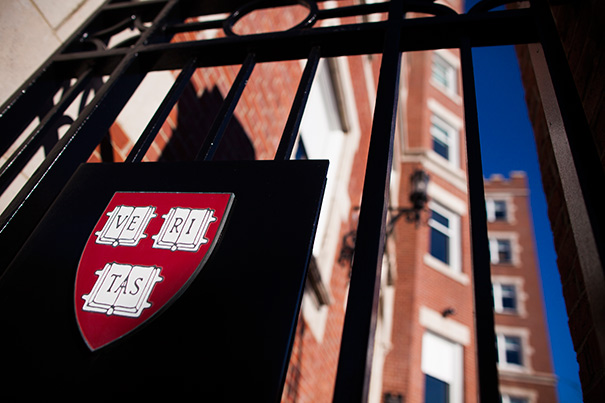
“Students and their families have many questions about the affordability of college in challenging financial times,” said William R. Fitzsimmons, dean of admissions and financial aid. “They are reassured when they learn how our financial aid program makes it possible for students from modest and middle-income families to come to Harvard.”
File photo by Stephanie Mitchell/Harvard Staff Photographer
Aid fuels record applications
Driven by financial assistance, 35,000 apply to Harvard College
Driven by historic levels of financial aid, the number of applications to Harvard College remained high this year. Applications reached a record 35,022, the third consecutive year with numbers near 35,000. Last year 34,303 applied, and two years ago 34,950 did.
“Financial aid continues to be a major factor in students’ decisions to apply to Harvard,” said William R. Fitzsimmons, dean of admissions and financial aid. “Students and their families have many questions about the affordability of college in challenging financial times. They are reassured when they learn how our financial aid program makes it possible for students from modest and middle-income families to come to Harvard.
“Generations of alumni have established a partnership with present and future undergraduates,” said Fitzsimmons. “Students, as always, contribute to the cost of their own education through term-time and summer work — and have the option of loans as well. Alumni generosity enables the College to provide $172 million this year to meet the financial needs of our remarkable undergraduates.”
“We are deeply grateful to President Drew Faust, Dean of the Faculty of Arts and Sciences Michael Smith, and Dean of the College Evelynn Hammonds for their continued leadership in sustaining Harvard’s core value of access for the nation’s and the world’s most promising students,” he said.
More than 60 percent of Harvard students receive need-based aid to attend, and on average their families pay only $11,500 annually. “Our financial aid program requires no contribution from the 20 percent of Harvard families with annual incomes below $65,000, and asks an average of no more than 10 percent of income from the majority of families receiving financial aid,” said Sarah C. Donahue, director of financial aid. “In addition, even families with incomes greater than $150,000 are eligible for aid, depending on their particular circumstances, such as having multiple children in college or unusual medical or other essential expenses.
“It appears that there is greater economic diversity in the applicant pool this year,” said Donahue. “We see a 37 percent increase in the number of students requesting a fee waiver, an indication of more applicants from low- and modest-income backgrounds.”
The demographics of this year’s and last year’s applicant pools are generally similar. “Minority students remain a significant segment of the applicant pool, the gender breakdown is still about 52 percent male, and geographical distribution is about the same, except for a slight decline in the number of applicants from Canada,” said Marlyn E. McGrath, director of admissions.
“We note another increase in applications from those interested in mathematics, physical sciences, and engineering — and a 26 percent increase in prospective computer scientists,” said McGrath. “The pattern of increases in these four areas began with the establishment of the School of Engineering and Applied Sciences (SEAS), and it is clear that SEAS has raised the level of visibility of our superb and expanded offerings in these fields of study.”
The admissions committee is now reviewing the applications of those deferred during early action, as well as those who applied for the Jan. 1 regular action program. Applicants will be notified of the committee’s decisions on March 28.
Admitted students will be invited to Cambridge for Visitas, the visiting program for prospective freshmen, to be held this year from April 20-22. Students have until May 1 to notify Harvard of their decision to enroll.




